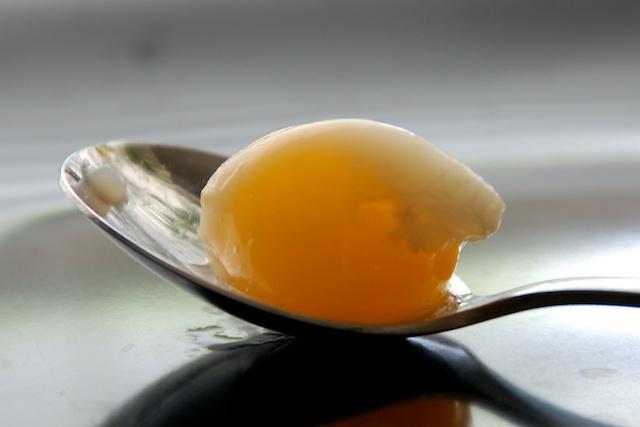-
Posts
10,190 -
Joined
-
Last visited
Content Type
Profiles
Forums
Store
Help Articles
Everything posted by Chris Hennes
-
But we're not really trying to recondition them here, right? If they are friends, and you are flexible, then who cares if they are "late" if you can create a meal that has an adaptable timetable? I agree that you can't invite habitually late and habitually on-time people to the same dinner, but you can certainly accomodate either at separate events. Many stews, for example, are very forgiving of being held relatively long times at serving temp. Also, meats cooked sous vide can often simply be held an additional hour with no loss in quality (not true of fish, unfortunately).
-
Peaches are in season and on sale, so of course I wound up with a bunch of them on today's trip to the grocery store. I'm looking for some savory-cooking ideas for some of these: peach salsa, maybe? Something to go with pork would be great.
-
+1. I've tried making cheese a couple times and the garbage I wind up with is distinctly inferior to anything produced by a reasonably good cheesemaker and can't touch the stuff made by the masters. I'm sure you could eventually develop a knack for making low-end cheese, but you're never going to make something that is as good as, say, Cabot Clothbound Cheddar at home (hell, even Cabot couldn't produce that one on their own, it was aged at Jasper Hills).
-
I'm not Nathan (obviously!) but I was just re-reading this section of Modernist Cuisine this morning in preparation for making some pastrami: 135°F is the wet-bulb temp they recommend there, and I think your method of measuring it is a good one. They suggest a dry-bulb temperature of 150°F at 65% RH: clearly your dry bulb was considerably higher than this. The key I think is that you don't want the internal temp to rise above the temperature you are going to sous vide it at (in your case 150°F), so when it comes up near that you will want to drop your smoker temperature down, or take the meat out (if you think it's had enough smoke).
-
Pickled Quail Eggs (p. 4•83) This is an interesting pickled egg: they are pickled out of the shell in a vinegar brine for 12 hours (I actually went longer because I was using the slightly larger Chukar egg, rather than quail). Then they are cooked Sous Vide at 62°C for 15 minutes. The white is supposed to stay attached, I think, but remain translucent: as you can see in the photo, not much of my whites survived the process. Only one of the eggs (not the one in the photo) had a substantial white still attached. Could this be due to the relative freshness of the eggs (which varied because I think these all came from a single bird)?
-
James Peterson's Vegetables: The Most Authoritative Guide to Buying, Preparing, and Cooking with More than 300 Recipes is good, too.
-
Any suggestions for how to store the Pickled Quail Eggs from p. 4•83?
-
In their excellent chapter on coffee the Modernist Cuisine folks recommend a number of books for further reading, in particular Rao's The Professional Barista's Handbook: An Expert Guide to Preparing Espresso, Coffee, and Tea, and Everything But Espresso: Professional Coffee Brewing Techniques.
-
If anything I'd expect the BeaterBlade to be gentler on your batters, by reducing the mixing time required: the continuous bowl-scraping action means not having to stop to scrape the bowl and then mix longer to incorporate, it happens in one smooth, continuous action.
-
Yes, I think that's the idea: but I believe this is the first time anyone has tried to apply for patent protection for their method of cutting. The idea of a process patent is not new, of course, but applying it to butchery is, AFAIK.
-
It's not real clear what it's going to mean, actually. It's obviously going to be protected by trademark (so your butcher won't be able to sell a "Las Vegas Strip" without paying for the privilege) but with a patent they are clearly going to actually attempt to prevent anyone from selling the same cut even under a different name without paying up. There is not a whole lot of legal precedent for this, that I am aware of.
-
Incidentally, Oklahoma State University is trying to patent (yes, patent) this cut.
-
I have few jars of homemade strawberry jam that I made when I still lived in Pennsylvania, so they must be about five years old now. I can't decide whether I trust my canning skills enough to actually eat them, though.
-
From the Cooking Issues Hydrocolloids Primer:
-

Commercial mayonnaise – likes, dislikes?
Chris Hennes replied to a topic in Food Traditions & Culture
OK, I could throw away most of the yolk and most of the lemon, or I could throw away a cup of oil, or I could keep a bottle of Hellman's in the fridge. Making two tablespoons of mayo is impractical, even if I could find a way to whip that little. -

Commercial mayonnaise – likes, dislikes?
Chris Hennes replied to a topic in Food Traditions & Culture
If you use one of these "French working jars" and a conical wisk, mayonnaise is stupid-easy. Ease isn't the only question: certainly, it's easy. But I have yet to come up with a way of making two tablespoons of mayo, so I wind up throwing away a good cup of the stuff every time I make it, because I just don't use that much. Except in the summer during tomato season, or when I go on a fried egg sandwich kick for a week, I just can't justify making the stuff, when Hellman's is almost as good. -

Commercial mayonnaise – likes, dislikes?
Chris Hennes replied to a topic in Food Traditions & Culture
Please. There is a substitute, it's called Hellman's. Completely reasonable for about 90% of my uses of mayo. And since my backyard has a disturbing lack of hens in it, I am forced to make even homemade mayonnaise from either store-bought or friend-provided eggs, but I gotta say it still tastes pretty good. -
This discussion deserves a bump, as I had Nutella on white bread as a snack a few minutes ago and it occurred to me that there might be other ways of eating the stuff. What else do you guys do with it?
-
I sometimes take the flavor profile of a bean dip and use whole, unmashed beans. It's more like a salad or even a tapenade in texture, but still scoopable onto chips, and somehow feels lighter.
-
I love the service, that looks great. I need to make these again sometime.
-
It's not a rule of thumb: the interior of a solid muscle really is sterile as far as pathogens are concerned. There are exceptions, but they are extremely rare. So your only concern is the exterior, and if your concern is how slowly the surface comes up to temp, a quick dip in boiling water will sterilize it too.
-
Which is sort of funny, considering where I currently live, but guilty as charged. Unfortunately, the nearest Culvers to me is 150 miles away. The nearest Steak'n'Shake is only 15, I can probably swing that.
-
Since the interior of the muscle is (assumed to be) sterile, this shouldn't be a major concern: the outside surface will come up to the oven's temperature reasonably quickly and it's smooth sailing from there, from a food-safety standpoint. Unless you've jaccarded the meat, of course.
-

Commercial mayonnaise – likes, dislikes?
Chris Hennes replied to a topic in Food Traditions & Culture
Another vote for Hellman's here.


